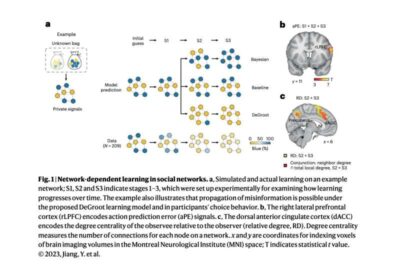Over the past decade or so, social scientists have been trying to understand how social networks can influence people's beliefs and behavior. Despite
Over the past decade or so, social scientists have been trying to understand how social networks can influence people’s beliefs and behavior. Despite the many studies on this topic, currently very little is known about how the human brain makes decisions in networked environments, when humans share their views with one another.
Shedding some light on what happens in the brain when humans are making decisions informed by interactions with others in their social network could also help to better understand phenomena commonly observed in social groups. For example, it could help to unveil the neural underpinnings behind misinformation, the propagation of information across social groups and polarized views.
Researchers at Peking University have recently carried out a study aimed at better understanding how humans learn new things from observing the decisions of others. Their findings, published in Nature Neuroscience, pin-point a neurocomputational mechanism through which the brain filters sources of information and that could explain phenomena like biased learning and misinformation.
“We suspected that the human brain processes information differently when the information is transmitted through social networks versus when it is not,” Lusha Zhu, one of the researchers who carried out the study, told Medical Xpress.
“This is because messages flowing along social connections are often entangled, contradictory, or unnecessary, making it very difficult for the brain to reconcile disparate sources of network-derived information. In our recent study, we asked the following questions: how does the brain integrate information received from connected peers? Why people perform differently when they are embedded in a same network? And how does the structural location of an individual on a network affect how that individual performs in a networked environment?”
As part of their study, Zhu and her colleagues asked groups of human participants to play a game that involved observing others’ behavior and learning from it. Basically, the participants were randomly allocated to different ‘locations’ in a temporary artificial society made of an interconnected network of people and could only communicate with people that were their direct ‘neighbors’ in this network configuration.
While the participants completed this group task, their brain activity was recording using functional magnetic resonance imaging (fMRI) technology. FMRI is a well-known imaging technique that allows researchers to create 3D and detailed images of brain activity when individuals are performing certain tasks.
“The goal of the subjects was to make a series of decisions by observing their neighbors’ decisions, similar to deciding which movie to watch on a weekend by checking out the one’s friends have watched,” Zhu explained. “We recorded subjects brain activity while subjects were observing each decision made by each neighbor.”
After recording their data, Zhu and her colleagues analyzed it using advanced computational models. These models allowed them to unveil connections between the brain activity they observed and the decisions made by their study participants, to gain insight on the brain processes involved in decision-making influenced by social networks.
“We find that the brain makes decisions in ways both similar to and different from that in the non-networked environment,” Zhu said. “Similar to the non-networked environment, our brain holds a belief about, say, the quality of the competing movies, and update the belief based on how surprising neighbors’ choices are. The more surprising the neighbors’ choices are, the more likely the brain is to update its belief.”
Zhu and her colleagues observed a very common learning signal in the prefrontal part of the participants’ brain, which reflected the process through which they updated their decisions after observing their neighbors’ decisions. Notably, they also detected brain activity patterns that differed from those observed while humans make decisions in non-networked situations.
More specifically, the researchers found that when making decisions in networked environments, the extent to which participants updated their beliefs varies according to the network locations of their neighbors. This extent varied based on how connected the participants were to neighbors in their network––something that is very different to belief updating in non-network environments.
“Essentially, our brain tends to assign higher weight to the observations by better connected neighbors and down-weight or even ignore the observations by less connected neighbors, even when these neighbors have valuable information,” Zhu explained. “We found that activity in a part of our brain called dorsal anterior cingulate cortex, which typically implicated in adjusting our behavior to adapt to the external environment, tracks how well connected a neighbor is at the time when the brain is processing a decision observed from the neighbor.”
The recent work by this team of researchers highlights brain mechanisms that could underly biased learning in social networks, which can in turn fuel the propagation of misinformation. In the future, it could inspire further studies examining the neural mechanisms they uncovered further.
“In our next works, we aim to understand how social animals gradually learn the structure of social networks, and how the brain stores and retrieves such information for flexible decision-making based on specific goals and contexts,” Zhu added.
Source: Medicalxpress.com


